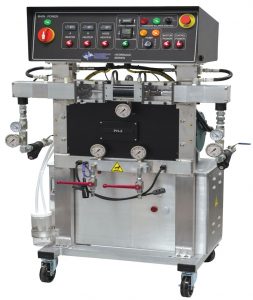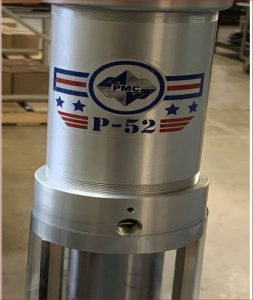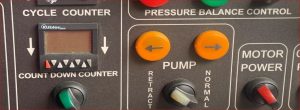Preventing Spray Foam Proportioners from Cavitating

Your goal as a spray foam equipment operator is to avoid cavitation at all costs.
Why does cavitation occur? What to be aware of and where to pay attention. How to avoid cavitation in your plural component spray foam and polyurea spray equipment. Cavitation could crack, break or explode a piston rod in your spray foam proportioner!
Plural component spray foam proportioners cavitate from a lack of chemical supply. Cavitation occurs when the Metering Pump requires a larger volume of material than the supply system (Transfer Pump) can furnish. The absence of chemicals creates a void of material in the Metering Pump. This situation causes starvation, and starvation of material leads to cavitation of the spray foam equipment machine.

Your goal as a spray foam equipment operator is to avoid cavitation at all costs. If cavitation does occur, it will wreak havoc on your plural component spray equipment machine. Also, it will have a devastating effect on the spray foam insulation or polyurea coatings application you’re currently working on. PMC has compiled a list of Do’s and Dont’s to limit the risk of cavitation due to lack of chemicals. Here are some tips on how a spray foam contractor or a polyurea coatings contractor can avoid cavitation in your spray equipment proportioner:
Do’s
- Do make sure the inlet screen at the Y Strainer is clean and free of any debris.
- Do have enough material in the drum for the job at hand. PMC’s proportioner comes standard with a Count Down Pre Set Timer. This monitoring tool is invaluable!
- Do adjust the air pressure supplied to the drum pumps to have the required 200-250psi material pressure feeding the machine.
- Do check the required temperature for the incoming material, as stated by the supplier. Less than optimal material temperature causes higher than normal viscosity, along with cavitation and unbalanced operating pressures.
- Do make sure all supply ball valves are open along with the air supply to drum pumps.
- Do make sure both drums, especially the “A” side, must be fitted with a desiccant moisture cartridge filter in the 1″ hole. There are two reasons.
- To supply “makeup” air to the drum, so it does not collapse.
- Supplies dry air into the drum to avoid crystallization.
- Do use your PMC Count Down Counter by setting the number of cycles (found in manual) the machine will pump before automatically turning off.
- Shut off the machine automatically when the barrel is low.
- Prevent empty barrels and pump cavitation.
Don’ts
- DO NOT have your supply hoses coming from drum pumps too short in length – make sure there is ample line to reach from the spray foam machine to the drum. This approach prevents your hose from kinking when moving drums and pumps into position.
- DO NOT place the transfer pumps into the chemical barrels without the correct bung adaptor. If the pumps are put directly into the drums without the bung adaptor, it will create issues:
Moisture will get into the A-side and cause a layer of crystalized material to form. The crystallized material could get sucked up into the drum pump. Crystallization could lead to a significant blockage in the Inlet/Y Strainer screen and eventually into the spray gun screens.
- Excessive crystalized material could also block the spray foam insulation proportioner and the high-pressure polyurea coating proportioner, and the accompanying heated hoses causing significant system pressure imbalances in the spray equipment machines.
- An open drum on the B side with Closed Cell Foam, especially during the summer months, allows the blowing agents to escape the drum and result in lower product yields and possibly higher chemical viscosity.
- DO NOT prop up the chemical drums to get “every last drop” of material from your drums. Utilize the PMC Count Down Counter. The count-down counter used for PMC spray foam equipment shuts off BEFORE you run the drums empty. The best practice is leaving a small amount of chemicals in the drums and transferring to a new drum using a funnel with a screen.
PMC’s Count Down Counter presents unique advantages to spray foam and polyurea applicators. Ensure the drum never goes empty by setting the counter to the appropriate cycle count (found in the manual for each machine), prevent damage to your transfer pump, and stop cavitation before it happens. A cavitating pump can damage the seals and cause pressure imbalance, leading to off-ratio spraying, which requires a pump rebuild to fix. Proper use of PMC’s Count Down Timer prevents downtime and increases efficiency.

PMC’s Count Down Counter presents unique advantages to spray foam and polyurea applicators.

Sign up for PMC’s FREE Spray Foam Insulation Equipment and Polyurea Coatings Equipment Blog https://82q51lnx.pages.infusionsoft.net





